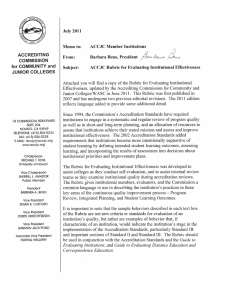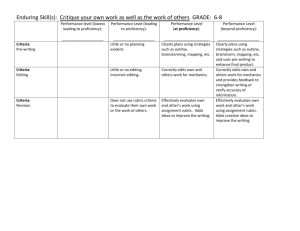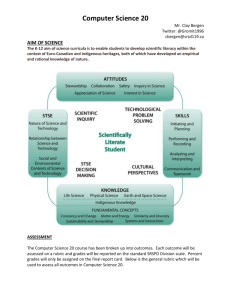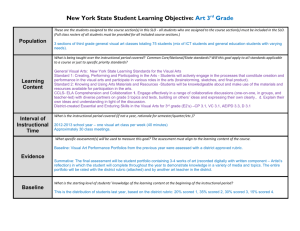Stephen F. Austin State University-Special Education Review Rubric
advertisement
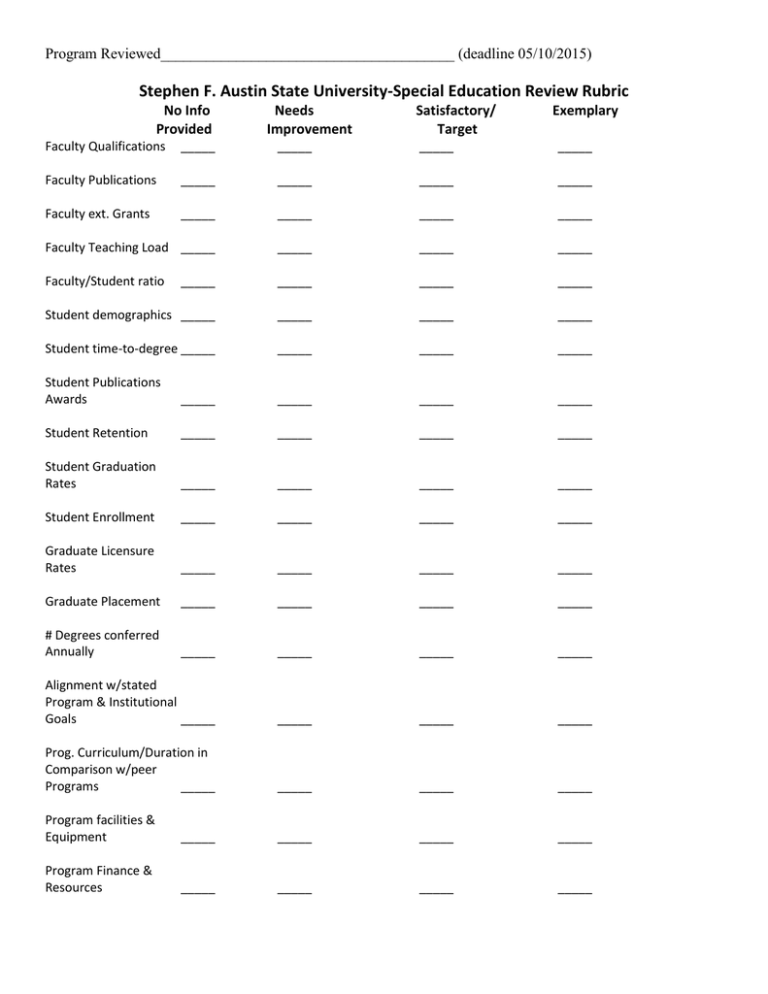
Program Reviewed_______________________________________ (deadline 05/10/2015) Stephen F. Austin State University-Special Education Review Rubric No Info Provided Needs Improvement Satisfactory/ Target Exemplary Faculty Qualifications _____ _____ _____ _____ Faculty Publications _____ _____ _____ _____ Faculty ext. Grants _____ _____ _____ _____ Faculty Teaching Load _____ _____ _____ _____ Faculty/Student ratio _____ _____ _____ _____ Student demographics _____ _____ _____ _____ Student time-to-degree _____ _____ _____ _____ Student Publications Awards _____ _____ _____ _____ Student Retention _____ _____ _____ _____ Student Graduation Rates _____ _____ _____ _____ Student Enrollment _____ _____ _____ _____ Graduate Licensure Rates _____ _____ _____ _____ Graduate Placement _____ _____ _____ _____ # Degrees conferred Annually _____ _____ _____ _____ Alignment w/stated Program & Institutional Goals _____ _____ _____ _____ Prog. Curriculum/Duration in Comparison w/peer Programs _____ _____ _____ _____ Program facilities & Equipment _____ _____ _____ _____ Program Finance & Resources _____ _____ _____ _____ Program Reviewed_______________________________________ (deadline 05/10/2015) No Info Provided Program Administration _____ Needs Improvement _____ Satisfactory/ Target _____ Exemplary _____ Program Reviewed_______________________________________ (deadline 05/10/2015) Rubric for Evaluating Instructional Effectiveness – Instructions The purpose of the rubric is to provide some common language that can be used to describe a program’s full adherence to the standards, as well as to provide a developmental framework for understanding each college’s actions toward achieving full compliance with standards. It is important to note the sample behaviors described in each text box of the rubric are examples of behavior that, if characteristic of a college and its programs, would indicate its stage of implementation of the standards. Program Reviewed:_______________________________________________________________ It is the hope that the program reviews reflect performance discussed in the rubric. Definitions: 1. Sustainable Continuous Quality Improvement level … demonstrates an ability to better the program’s processes by increasing efficiency of the program, increasing internal (meaning, faculty) and external (meaning, candidates) satisfaction, and has an ongoing process that evaluates how the program works and ways to improve it processes. 2. Proficiency level … 0 No Evidence No Evidence to access 1 Attempting Standards Needs improvements to meet proficiency Demonstrates unclear or minimal understanding of the standards Evidence of support data, dialogue, etc. is insignificant 2 Approaching standards 3 Meeting Standards 4 Exceeding Standards Approaching proficiency Consistently meets proficiency Consistently exceeds proficiency Demonstrates basic Demonstrates understanding of the understanding of the standards with gaps standards and errors Demonstrates a deeper understanding of the standards Evidence of support data, dialogue, etc. is inconsistent or incomplete Evidence of data, dialogue, etc. extends to higherlevel thinking strategies or creative connectedness Evidence of the data, dialogue, etc. contains few or minor errors It is expected that the college and its programs be at the Sustainable Continuous Quality Improvement level of instructional and non-instructional programs and services. It is expected that the college and its programs be at the Sustainable Continuous Quality Improvement level in Planning. It is expected that the college and its programs be at the development level or above in Student Learning Outcomes. It is expected that the college and its programs be at the Proficiency level in the identification assessment and use for improvements of student learning outcomes. Program Reviewed_______________________________________ (deadline 05/10/2015) Rubric for Evaluating Instructional Effectiveness – Part I: Program Review Levels of Implementation Characteristics of Institutional Effectiveness in Program Review Yes No There is preliminary investigative dialogue at the program level about what data or process should be used for program review. There is recognition of existing practices and models in program review that Awareness make use of program research. The program is implementing program review models. Program review is embedded in practice across the institution using qualitative and quantitative data to improve program effectiveness. Dialogue about the results of program review is evident within the program as part of discussion of program effectiveness. Leadership groups throughout the college accept responsibility for program review framework development (administration, etc.) Development Appropriate resources are allocated to conducting program review of meaningful quality. Development of a framework for linking results of program review to planning for improvement. Development of a framework to align results of program review to resource allocation. Program review processes are in place and implemented regularly. Results of all program reviews are integrated into institution-wide planning for improvement and informed decision-making. The program review framework is established and implemented. Dialogue about the results of all program reviews is evident throughout the college as a part of discussion of institutional effectiveness Proficiency Results of program review are clearly and consistently linked to institutional planning processes and resource allocation processes; college can demonstrate or provide specific examples. The college evaluates the effectiveness of its program review processes in supporting and improving student achievement and student learning outcomes. Program review processes are ongoing, systematic and used to assess and improve student learning and achievement. The college reviews and refines its program review processes to improve Sustainable Continuous Quality college effectiveness. Improvement The results of program review are used to continually refine and improve program practices resulting in appropriate improvements in student achievement and learning. Program Reviewed_______________________________________ (deadline 05/10/2015) Rubric for Evaluating Instructional Effectiveness – Part II: Planning Levels of Implementation Characteristics of Institutional Effectiveness in Program Review Yes No The program has preliminary investigative dialogue about planning processes. There is recognition of case need for quantitative and qualitative data and analysis in planning The program has initiated pilot projects and efforts in developing systematic cycle of evaluation, integrated planning and implementation (e.g., in human or physical resources). Awareness Planning found in only some areas of program operations There is exploration of models and definitions and issues related to planning. There is minimal linkage between plans and a resource allocation process, perhaps planning for use of “external funding” The program may have a consultant-supported plan for facilities, or a strategic plan. The college has defined a planning process and assigned responsibility for implementing it. The college has identified quantitative and qualitative data and is using it. Planning efforts are specifically linked to college mission and goals. Development The college uses applicable quantitative data to improve institutional effectiveness in some areas of operation. Governance and decision-making processes incorporate review of college effectiveness in mission and plans for improvement. Planning processes reflect the participation of a broad constituent base. The program has a well-documented, ongoing process for evaluating itself in all areas of operation, analyzing and publishing the results and planning and implementing improvements. The college component plans are integrated into a comprehensive plan to achieve broad educational purposes and improve institutional effectiveness. The program effectively uses its human, physical, technology, and financial resources to achieve its broad educational purposes, including state student learning outcomes. Proficiency The program has documented assessment results and communicated matters of quality assurance to appropriate constituencies (documents data and analysis of achievement of its educational mission). The program assesses progress toward achieving its education goals over time (uses longitudinal data and analyses). The college plans and effectively incorporates results of program review in all areas of educational services: instruction support services, library and learning resources. The college uses ongoing and systematic evaluation and planning to refine its key processes and improve student learning. Sustainable Continuous Quality There is dialogue about institutional effectiveness that is ongoing, robust and Improvement pervasive; data and analyses are widely distributed and used throughout the college. Program Reviewed_______________________________________ (deadline 05/10/2015) Levels of Implementation Characteristics of Institutional Effectiveness in Program Review Yes No There is ongoing review and adaptation of evaluation and planning processes. There is consistent and continuous commitment to improving student learning; and educational effectiveness is a demonstrable priority in all planning structures and processes. Rubric for Evaluating Instructional Effectiveness – Part III: Student Learning Outcomes Levels of Implementation Characteristics of Institutional Effectiveness in Program Review Yes No Awareness Development Proficiency There is preliminary, investigative dialogue about student learning outcomes. There is recognition of existing practices such as course assessments and how they relate to student learning outcomes. There is exploration of models, definitions, and issues taking place. The program has discussed whether to define student learning outcomes at the level of some courses or programs or degrees; where to begin. Program has established a framework for defining student learning outcomes (where to start), how to extend, and timeline. Program has established authentic assessment strategies for assessing student learning outcomes as appropriate to intended course, program, and degree learning outcomes. Existing organizational structures (faculty, meetings, teaming) are supporting strategies for student learning outcomes definition and assessment. Leadership groups (e.g., faculty, administration) have accepted responsibility for student learning outcomes implementation. Appropriate resources are being allocated to support student learning outcomes and assessment. Faculty and staff are fully engaged in student learning outcomes development. Student learning outcomes and authentic assessment are in place for courses, programs and degrees. Results of assessment are being used for improvement and further alignment of institution-wide practices. There is widespread institutional dialogue about the results. Decision-making includes dialogue on the results of assessment and is purposefully directed toward improving student learning. Appropriate resources continue to be allocated and fine-tuned. Comprehensive assessment reports exist and are completed on a regular basis. Course student learning outcomes are aligned with degree student learning outcomes. Students demonstrate awareness of goals and purposes of courses and Program Reviewed_______________________________________ (deadline 05/10/2015) Levels of Implementation Characteristics of Institutional Effectiveness in Program Review Yes No program in which they are enrolled. Student learning outcomes and assessment are ongoing, systematic and used for continuous quality improvement. Dialogue about student learning is ongoing, pervasive and robust. Sustainable Continuous Quality Evaluation and fine-tuning of organizational structures to support student Improvement learning is ongoing. Student learning improvement is a visible priority in all practices and structures across the program. Learning outcomes are specifically linked to program reviews. Comments:
